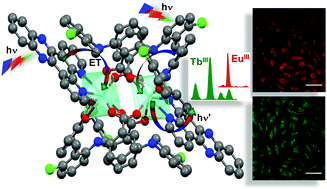Luminescent EuIII and TbIII bimetallic complexes of N,N′-heterocyclic bases and tolfenamic acid: structures, photophysical aspects and biological activity†
Abstract
Four new homodinuclear isostructural luminescent EuIII and TbIII complexes containing N,N-heterocyclic bases (DPQ/DPPZ) and tolfenamic acid (TFA) presented as [Ln2(DPQ/DPPZ)2(TFA)6], where LnIII = EuIII [DPQ (1), and DPPZ (2)] and TbIII [DPQ (3) and DPPZ (4)], were studied in this work. The planar DPQ/DPPZ ligands used are well-known intercalators and photosensitizers. Tolfenamic acid (TFA) used as an anthranilic acid derivative-based NSAID, provides the hard carboxylate-O-donor for hard LnIII Lewis acids, and can form a bridge between two LnIII ions. The SC-XRD studies on the dinuclear complexes revealed their isostructural nature in the solid state. This is due to the similarity of both LnIII ions, exhibiting identical ligand disposition in 3D and electronic interactions with the ligands. All the complexes possess Ci symmetry, making the coordination environment around each LnIII identical. The two LnIII ions in the dimeric structures are bridged by –COO− groups of the four TFA molecules in a μ-η1:η1 coordination mode. Additionally, one TFA is coordinated to each LnIII in an η2-chelating mode together with one bidentate N,N-donor DPQ/DPPZ ligand. Therefore, each EuIII/TbIII ion ultimately possesses an eight-coordinated {Ln2N2O6} square antiprismatic geometry. The luminescent complexes showed the characteristic (5DJ → 7FJ) f–f transitions in solution with a quantum yield in the range of 8–20%, and thus were utilized for cellular fluorescence imaging studies. The affinity of the complexes with biological targets such as DNA and serum albumin was studied. The cellular uptake and bioimaging potential of the luminescent compounds in MCF-7 and HeLa cancer cells were probed using confocal fluorescence imaging studies. The sufficient internalization of the LnIII-probes in the cells observed from the intrinsic luminescence from EuIII/TbIII demonstrated their non-selective cytosolic and nuclear localization. The complexes were photo-cytotoxic at 365 nm mediated by the ROS generated from the photo-excitation of the DPQ/DPPZ sensitizers.



 Please wait while we load your content...
Please wait while we load your content...